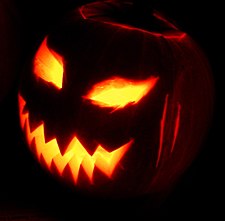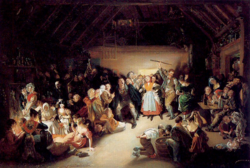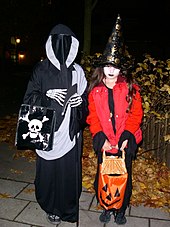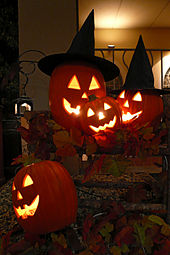| Halloween | |
|---|---|
 A Jack-o'-lantern | |
| Also called | All Hallows’ Eve All Saints’ Eve |
| Observed by | Around the world |
| Date | October 31 |
| Observances | Costume parties, trick-or-treating, carving pumpkins, ghost tours, haunted attractions, bonfires, divination, apple bobbing, fireworks displays |
| Related to | Samhain, All Saints’ Day (cf. vigils) |
Contents |
History
Historian Nicholas Rogers, exploring the origins of Halloween, notes that while "some folklorists have detected its origins in the Roman feast of Pomona, the goddess of fruits and seeds, or in the festival of the dead called Parentalia, it is more typically linked to the Celtic festival of Samhain, whose original spelling was Samuin (pronounced sow-an or sow-in)".[1] The name is derived from Old Irish and means roughly "summer's end".[1]
Snap-Apple Night (1832) by Daniel Maclise.
Depicts apple bobbing and divination games at a Halloween party in Blarney, Ireland.
Depicts apple bobbing and divination games at a Halloween party in Blarney, Ireland.
Origin of name
| This subsection may need to be rewritten entirely to comply with Wikipedia's quality standards, as it contains inappropriate/misinterpreted citations. You can help. The discussion page may contain suggestions. (November 2010) |
Symbols
Development of artifacts and symbols associated with Halloween formed over time. For instance, the carving of jack-o'-lanterns springs from the souling custom of carving turnips into lanterns as a way of remembering the souls held in purgatory.[5] The carving of pumpkins is associated with Halloween in North America where pumpkins are both readily available and much larger – making them easier to carve than turnips.[6] The American tradition of carving pumpkins preceded the Great Famine period of Irish immigration[7] and was originally associated with harvest time in general, not becoming specifically associated with Halloween until the mid-to-late 19th century.[8][9]The imagery of Halloween is derived from many sources, including national customs, works of Gothic and horror literature (such as the novels Frankenstein and Dracula), and classic horror films (such as Frankenstein and The Mummy).[10] Among the earliest works on the subject of Halloween is from Scottish poet John Mayne in 1780, who made note of pranks at Halloween; "What fearfu' pranks ensue!", as well as the supernatural associated with the night, "Bogies" (ghosts), influencing Robert Burns' Halloween 1785.[11] Elements of the autumn season, such as pumpkins, corn husks, and scarecrows, are also prevalent. Homes are often decorated with these types of symbols around Halloween.
Halloween imagery includes themes of death, evil, the occult, or mythical monsters.[12] Black and orange are the holiday's traditional colors.
Trick-or-treating and guising
Main article: Trick-or-treating

Trick-or-treating in Sweden
The practice of dressing up in costumes and begging door to door for treats on holidays dates back to the Middle Ages and includes Christmas wassailing. Trick-or-treating resembles the late medieval practice of souling, when poor folk would go door to door on Hallowmas (November 1), receiving food in return for prayers for the dead on All Souls' Day (November 2). It originated in Ireland and Britain,[13] although similar practices for the souls of the dead were found as far south as Italy.[14] Shakespeare mentions the practice in his comedy The Two Gentlemen of Verona (1593), when Speed accuses his master of "puling [whimpering or whining] like a beggar at Hallowmas."[15]
In Scotland and Ireland, Guising — children disguised in costume going from door to door for food or coins — is a traditional Halloween custom, and is recorded in Scotland at Halloween in 1895 where masqueraders in disguise carrying lanterns made out of scooped out turnips, visit homes to be rewarded with cakes, fruit and money.[16] The practise of Guising at Halloween in North America is first recorded in 1911, where a newspaper in Kingston, Ontario reported children going "guising" around the neighborhood.[17]
American historian and author Ruth Edna Kelley of Massachusetts wrote the first book length history of the holiday in the U.S; The Book of Hallowe'en (1919), and references souling in the chapter "Hallowe'en in America";
The taste in Hallowe'en festivities now is to study old traditions, and hold a Scotch party, using Burn's poem Hallowe'en as a guide; or to go a-souling as the English used. In short, no custom that was once honored at Hallowe'en is out of fashion now.[18]In her book, Kelley touches on customs that arrived from across the Atlantic; "Americans have fostered them, and are making this an occasion something like what it must have been in its best days overseas. All Hallowe'en customs in the United States are borrowed directly or adapted from those of other countries".[19]
While the first reference to "guising" in North America occurs in 1911, another reference to ritual begging on Halloween appears, place unknown, in 1915, with a third reference in Chicago in 1920.[20]
The earliest known use in print of the term "trick or treat" appears in 1927, from Blackie, Alberta, Canada:
Hallowe’en provided an opportunity for real strenuous fun. No real damage was done except to the temper of some who had to hunt for wagon wheels, gates, wagons, barrels, etc., much of which decorated the front street. The youthful tormentors were at back door and front demanding edible plunder by the word “trick or treat” to which the inmates gladly responded and sent the robbers away rejoicing.[21]The thousands of Halloween postcards produced between the turn of the 20th century and the 1920s commonly show children but do not depict trick-or-treating.[22] The editor of a collection of over 3,000 vintage Halloween postcards writes, "There are cards which mention the custom [of trick-or-treating] or show children in costumes at the doors, but as far as we can tell they were printed later than the 1920s and more than likely even the 1930s. Tricksters of various sorts are shown on the early postcards, but not the means of appeasing them".[23] Trick-or-treating does not seem to have become a widespread practice until the 1930s, with the first U.S. appearances of the term in 1934,[24] and the first use in a national publication occurring in 1939.[25]
Costumes
Main article: Halloween costume

People dressing in Halloween Costumes in Dublin.
Dressing up in costumes and going "guising" was prevalent in Scotland at Halloween by the late 19th century.[16] Costuming became popular for Halloween parties in the US in the early 20th century, as often for adults as for children. The first mass-produced Halloween costumes appeared in stores in the 1930s when trick-or-treating was becoming popular in the United States.
Halloween costume parties generally fall on, or around, 31 October, often falling on the Friday or Saturday prior to Halloween.
UNICEF
Main article: Trick-or-Treat for UNICEF
"Trick-or-Treat for UNICEF" has become a common sight during Halloween in North America. Started as a local event in a Northeast Philadelphia neighborhood in 1950 and expanded nationally in 1952, the program involves the distribution of small boxes by schools (or in modern times, corporate sponsors like Hallmark, at their licensed stores) to trick-or-treaters, in which they can solicit small-change donations from the houses they visit. It is estimated that children have collected more than $118 million for UNICEF since its inception. In Canada, in 2006, UNICEF decided to discontinue their Halloween collection boxes, citing safety and administrative concerns; after consultation with schools, they instead redesigned the program.[26][27]Games and other activities

In this Halloween greeting card from 1904, divination is depicted: the young woman looking into a mirror in a darkened room hopes to catch a glimpse of the face of her future husband.
Some games traditionally played at Halloween are forms of divination. A traditional Scottish form of divining one's future spouse is to carve an apple in one long strip, then toss the peel over one's shoulder. The peel is believed to land in the shape of the first letter of the future spouse's name.[30] Unmarried women were told that if they sat in a darkened room and gazed into a mirror on Halloween night, the face of their future husband would appear in the mirror. However, if they were destined to die before marriage, a skull would appear. The custom was widespread enough to be commemorated on greeting cards[31] from the late 19th century and early 20th century.
The telling of ghost stories and viewing of horror films are common fixtures of Halloween parties. Episodes of television series and Halloween-themed specials (with the specials usually aimed at children) are commonly aired on or before the holiday, while new horror films are often released theatrically before the holiday to take advantage of the atmosphere.
Haunted attractions
Main article: Haunted attraction
Haunted attractions are entertainment venues designed to thrill and scare patrons. Most attractions are seasonal Halloween businesses. Origins of these paid scare venues are difficult to pinpoint, but it is generally accepted that they were first commonly used by the Junior Chamber International (Jaycees) for fundraising.[32] They include haunted houses, corn mazes, and hayrides,[33] and the level of sophistication of the effects has risen as the industry has grown. Haunted attractions in the United States bring in an estimate $300–500 million each year, and draw some 400,000 customers, although press sources writing in 2005 speculated that the industry had reached its peak at that time.[32] This maturing and growth within the industry has led to more technically-advanced special effects and costuming, comparable with that of Hollywood films.[34]Foods
Because the holiday comes in the wake of the annual apple harvest, candy apples (known as toffee apples outside North America), caramel or taffy apples are common Halloween treats made by rolling whole apples in a sticky sugar syrup, sometimes followed by rolling them in nuts.At one time, candy apples were commonly given to children, but the practice rapidly waned in the wake of widespread rumors that some individuals were embedding items like pins and razor blades in the apples.[35] While there is evidence of such incidents,[36] they are quite rare and have never resulted in serious injury. Nonetheless, many parents assumed that such heinous practices were rampant because of the mass media. At the peak of the hysteria, some hospitals offered free X-rays of children's Halloween hauls in order to find evidence of tampering. Virtually all of the few known candy poisoning incidents involved parents who poisoned their own children's candy.[37]
One custom that persists in modern-day Ireland is the baking (or more often nowadays, the purchase) of a barmbrack (Irish: báirín breac), which is a light fruitcake, into which a plain ring, a coin and other charms are placed before baking. It is said that those who get a ring will find their true love in the ensuing year. This is similar to the tradition of king cake at the festival of Epiphany.
List of foods associated with the holiday:
- Barmbrack (Ireland)
- Bonfire toffee (Great Britain)
- Candy apples/toffee apples
- Candy corn, candy pumpkins (North America)
- Caramel apples
- Caramel corn
- Colcannon (Ireland)
- Novelty candy shaped like skulls, pumpkins, bats, worms, etc.
- Pumpkin, pumpkin pie, pumpkin bread
- Roasted pumpkin seeds
- Roasted sweet corn
- Soul cakes
Around the world
Main article: Halloween around the world
Halloween is not celebrated in all countries and regions of the world, and among those that do the traditions and importance of the celebration vary significantly. In Scotland and Ireland, traditional Halloween customs include children dressing up in costume going "guising", holding parties, while other practices in Ireland include lighting bonfires, and having firework displays.[38][39] Mass transatlantic immigration in the 19th century popularized Halloween in North America, and celebration in the United States and Canada has had a significant impact on how the event is observed in other nations. This larger North American influence, particularly in iconic and commercial elements, has extended to places such as South America, Australia,[40] New Zealand,[41] continental Europe, Japan, and other parts of East Asia.[42]Religious perspectives
See also: All Saints and Samhain
Christianity
Christian attitudes towards Halloween are diverse. In the Anglican Church, some dioceses have chosen to emphasize the Christian traditions of All Saints’ Day,[43][44] while some other Protestants celebrate the holiday as Reformation Day, a day to remember the Protestant Reformation.[45][46] Father Gabriele Amorth, a Vatican-appointed exorcist in Rome, has said, "if English and American children like to dress up as witches and devils on one night of the year that is not a problem. If it is just a game, there is no harm in that."[47] In more recent years, the Roman Catholic Archdiocese of Boston has organized a "Saint Fest" on the holiday.[48] Similarly, many contemporary Protestant churches view Halloween as a fun event for children, holding events in their churches where children and their parents can dress up, play games, and get candy.Many Christians ascribe no negative significance to Halloween, treating it as a purely secular holiday devoted to celebrating "imaginary spooks" and handing out candy. To these Christians, Halloween holds no threat to the spiritual lives of children: being taught about death and mortality, and the ways of the Celtic ancestors actually being a valuable life lesson and a part of many of their parishioners' heritage.[49] In the Roman Catholic Church Halloween is viewed as having a Christian connection,[50] and Halloween celebrations are common in Catholic parochial schools throughout North America and in Ireland.
Some Christians feel concerned about Halloween, and reject the holiday because they feel it trivializes – or celebrates – paganism, the occult, or other practices and cultural phenomena deemed incompatible with their beliefs.[51] A response among some fundamentalist and conservative evangelical churches in recent years has been the use of 'Hell houses', themed pamphlets, or comic-style tracts such as those created by Jack T. Chick in order to make use of Halloween's popularity as an opportunity for evangelism.[48] Some consider Halloween to be completely incompatible with the Christian faith[52] believing it to have originated as a pagan "Festival of the Dead".




No comments:
Post a Comment